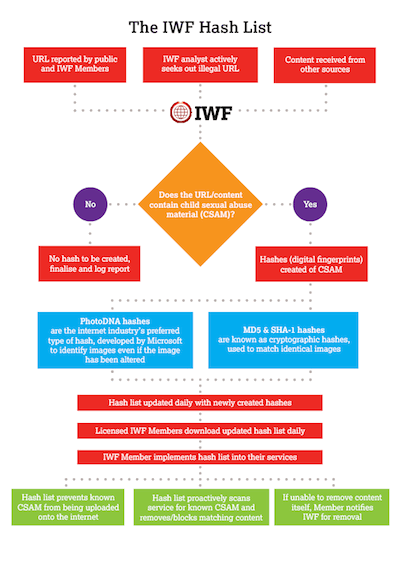This article is more than 1 year old
IWF shares 'hash list' with web giants to flush out child sex abuse images online
UK org tracks illegal material with new tech, gov database
The UK's telco-backed Internet Watch Foundation has distributed a hash list of child abuse images to the likes of Google, Facebook and Twitter – in an attempt to hasten the removal of such content across the globe.
Microsoft's PhotoDNA was one of the technologies used by the IWF to create the hashes, which serve as digital fingerprints of an image.
The organisation, which – among other things – provides ISPs with a blocklist of child sexual abuse URLs of unlawful content that is hosted outside of the UK, added that it would also create MD5 and SHA-1 hashes "to meet the needs of the online industry."
IWF analysts, who have the gruelling task of sifting through photos and videos showing children being sexually exploited, will generate the hashes from images that they have assessed.
However, for now, the IWF can only offer hashes of still images. It said it was working with one of its members to trial video hashing software. But no word yet on when this will be made available.

Child sex abuse pics may have been reported by a member of the public, spotted by analysts, flagged up by an online biz or taken from the Home Office's new Child Abuse Image Database (CAID).
Microsoft, Facebook, Google, Twitter and Yahoo! are the only companies to have access to the hash list at present. The organisation added that it planned to roll it out to all eligible members of the IWF soon.
IWF chief Susie Hargreaves said that the hash list "could be a game-changer" in helping to hunt down child sex abuse image peddlers online.
She added:
This is something we have worked on with our members since the Prime Ministers’ #WePROTECT summit last December.
We’ll soon be able to offer the hash list to all IWF members, who are based around the world. It means victims’ images can be identified and removed more quickly, and we can prevent known child sexual abuse images from being uploaded to the internet in the first place.
The org, which has a licence to govern the use of the hash list, said that members who had been granted access to the hashes had been required to first pass the IWF's vetting checks.
"The IWF controls the compilation and dissemination of the hash list. The IWF member licensed to download this list is responsible for its correct implementation," it said.
As of the end of 2014, the Home Office's CAID national database held 4.4 million images and over 30 million hashes. ®
